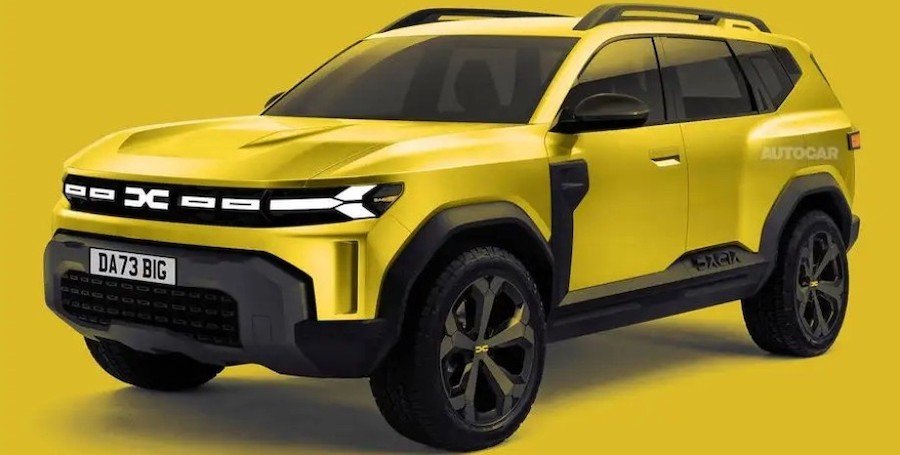The Dacia Bigster is one of a trio of new cars coming from Dacia that will kick-start an ambitious push to expand its footprint in the crucial C-segment while reaffirming its commitment to accessibility.
Expanding in this market (in which it currently sells only the Duster SUV) will help the Romanian value brand to build on its rapid growth in Europe. This will allow Dacia to better compete with similarly positioned rivals (such as Skoda and Suzuki) that cater to wider target markets with more expansive model ranges.
Devised as a rugged but road-focused rival to the likes of the Peugeot 5008 and Skoda Kodiaq, the Bigster will be the largest and most expensive model in the Dacia portfolio when it is launched in early 2025. But it will still embody the same value-for-money ethos as its Dacia Duster, Dacia Sandero hatchback and Dacia Jogger MPV siblings – a characteristic that Dacia bosses highlight as a key tenet of the brand’s appeal.
The Bigster will be based on the same CMF platform as its similar-size Renault Group siblings, the Nissan X-Trail and Renault Austral, and is being engineered from the off with an outright focus on affordability.
“We know that pricing for customers is key, so pricing can’t be just a consequence of the technological choices we make,” said the brand’s sales and marketing boss, Xavier Martinet. “It has to be an input in the product before asking our product planning and engineering colleagues.”
Just as the Sandero and Duster are comfortably among the most affordable models in their market segments, so too will the Bigster look to capture a significant market share by undercutting established rivals.
Dacia has previously suggested that the Bigster will be priced more in line with what consumers expect of the segment below, hinting at just a small premium over the Duster, which will enter its third generation next year.
When asked how this would be possible, Dacia CEO Denis Le Vot said: “Our recipe is super-clear. We’re making the essential car. We design cars with zero superfluous content: no screen when we can put no screen, no electronics when we can put no electronics, no ADAS when we can put no ADAS.”
This is a formula that Dacia has already applied to great success with its latest models. It posted a 6.8% global sales uptick in 2022, with 573,800 units, making it the third best-selling brand to private customers in Europe.
While stripping back the amount of kit fitted to the Bigster will be instrumental in keeping its price low, it is the use of existing Renault Group hardware that really enables Dacia to minimise its development costs and thereby the final price.
In keeping with the brand’s emphasis on simplicity, the Bigster will be available with only a small selection of trim levels, but it is expected to match its Nissan and Renault relations in offering a choice of either pure-combustion or electrified power.
The latter will most likely be derived from Renault’s E-Tech full-hybrid system, as used by the Jogger Hybrid, Dacia’s first electrified car.
Four-wheel drive will no doubt be an option as well. “We are taking the assets from the group, and we’re lucky that we don’t have to pre-invest, that we don’t have to be a front-runner,” explained Le Vot, before confirming that Dacia will “continue leveraging the asset by introducing two new models just after the Bigster”. He refused to confirm further details, though.
A likely addition would be a Sandero-based wagon to serve as a successor to the retired Logan MCV and as a rival to the hugely popular Skoda Octavia Estate, while an entry-level car in the vein of the Nissan Juke would enhance Dacia’s coverage of the highly competitive compact crossover segment.
Vans not included in Dacia's plan
While Dacia is looking to dramatically expand the scope of its car offering, a return to the lucrative light commercial vehicle market isn’t on the radar of CEO Denis Le Vot, partly because parent company Renault is already a big player in this sector.
“Well, I don’t know how we differentiate; that’s why we stopped,” he laughed, referring to the panel-sided variant of the Dokker MPV that was taken out of production in 2021.
Le Vot explained the considerations that must be made to cater to a buyer in this segment: “What is a mid-size van? What is the multi-energy of a mid-size van that permits me to go to the countryside but still at the same time enter the city etc? And the line between all these is kind of moving. I would say even undefined.”

